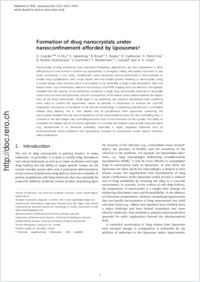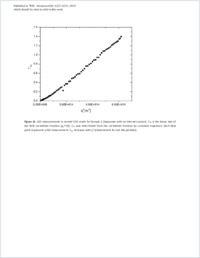Formation of drug nanocrystals under nanoconfinement afforded by liposomes
- Cipolla, D. Faculty of Pharmacy, The University of Sydney, Australia - Aradigm Corporation, Hayward, USA
- Wu, H. Aradigm Corporation, Hayward, USA
- Salentinig, Stefan Laboratory for Biointerfaces, Department Materials meet Life, Empa, Swiss Federal Laboratories for Materials Science and Technology, St. Gallen, Switzerland
- Boyd, B. Monash Institute of Pharmaceutical Sciences, Monash, Australia
- Rades, T. Department of Pharmaceutical Sciences, University of Copenhagen, Denmark
- Vanhecke, Dimitri Adolphe Merkle Institute, Université de Fribourg, Fribourg, Switzerland
- Petri-Fink, Alke Adolphe Merkle Institute, Université de Fribourg, Fribourg, Switzerland
- Rothen-Rutishauser, Barbara Adolphe Merkle Institute, Université de Fribourg, Fribourg, Switzerland
- Eastman, S. ProNAi Therapeutics, Vancouver, Canada
- Redelmeier, T. Northern Lipids Inc., Burnaby, Canada
- Gonda, I. Aradigm Corporation, Hayward, USA
- Chan, H. K. Faculty of Pharmacy, The University of Sydney, Australia
-
14.01.2016
Published in:
- RSC Advances. - 2016, vol. 6, no. 8, p. 6223–6233
English
Nanocrystals of drug substances have important therapeutic applications, but their preparation is often difficult due to size control in bottom up approaches, or energetic milling and surface activation in top down processing. In this study, confinement within liposome nanocompartments is demonstrated to enable drug crystallization with a high aspect ratio but limited growth resulting in nanocrystals, using a simple freeze–thaw process which is anticipated to be amenable to large scale preparation. After the freeze–thaw, cryo-transmission electron microscopy (cryoTEM) imaging and cryo-electron tomography revealed that the majority of the liposomes contained a single drug nanocrystal, observed to physically stretch but not burst the liposomes, and the composition of the freeze–thaw medium altered the aspect ratio of the drug nanocrystals. Small angle X-ray scattering and dynamic depolarized light scattering were used to confirm the asymmetric nature of particles in suspension to exclude the cryoTEM preparation process as a contributor to the particle morphology. In assessing potential use in controlled release drug delivery, the in vitro release rate of ciprofloxacin from liposomes containing the nanocrystals revealed that the rate of dissolution of the nanocrystals became the rate controlling step, in contrast to the lipid bilayer rate controlling function prior to the formation of the crystals. The ability to modulate the release rate of the active ingredient in a complex formulation using simple physical means (e.g., freeze/thaw) is an attractive possibility, especially in highly regulated industries such as pharmaceuticals where qualitative and quantitative changes of composition would require extensive safety evaluations.
- Faculty
- Faculté des sciences et de médecine
- Department
- Département de Chimie
- Language
-
- English
- Classification
- Chemistry
- License
- License undefined
- Identifiers
-
- RERO DOC 258824
- DOI 10.1039/C5RA25898G
- Persistent URL
- https://folia.unifr.ch/unifr/documents/304921
Other files
Statistics
Document views: 49
File downloads:
- fin_fdn.pdf: 106
- fin_fdn_sm.pdf: 100

